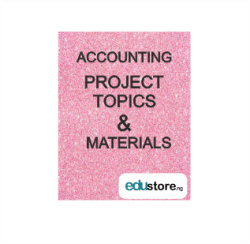EQUIPMENT LEASING AS A SOURCE OF FINANCE, PRACTICE, PROBLEMS AND PROSPECTS
(A CASE STUDY OF FIDELITY MERCHANT BANK ONITSHA)
PROPOSAL
In the course of my research work at Fidelity Merchant Bank(FMB) in Onitsha, I have found out that equipment leasing has become a source of finance. Also, my in depth study on equipment leasing has proven that is establishment will help very tremendously in financing investments.
Though the relevance of equipment leasing cannot be over –emphasized, it has its practices, problems and prospects. Having critically studied the problems associated with equipment leasing, I shall proffer solutions to them in conjunction with the authorities in the field with a particular reference to Fidelity Merchant Bank, Onitsha. My aim is geared towards putting in place a smooth leasing system as well as running the bank efficiently and effectively.
ABSTRACT
This aim of this study is to find out how the establishment of equipment leasing in the federation helped in financing investments. To carry out the study, four research questions and four hypothesis were formulated some are derived from the review of related literature.
In the study, a questionnaire was used to collect relevant data from the staff of fidelity merchant bank, onitsha, the case study and from some investing firms.
The findings revealed that FMB has positive perception that the establishment of equipment leasing in the federation helped in improvement of investments while lessess also have positive perception, better perception on all the issues raised in the research work.
The relative recent development of leasing in Nigeria as compared to other forms of credit has been said to be the reason for the stunning lack of information about it and the options it offers to the business concern in Nigeria. This lack of information is pitiful in that most members of the public are not even aware of its presence in Nigeria. The need for organized and comprehensive information could not be over emphasized.
Furthermore, being new, most investors are not really well informed as to the profitability or otherwise of leasing as finance option, hence, the low level of forms that engage in leasing which goes to compound the problem of the Nigeria investor not having much choice as to the best alternative available to him.
Subsequently, this study will go a long way in projecting the profitability and future prospects of leasing business in Nigeria and also contributing to the development of leasing in Nigeria which under the present economic conditions, its importance can not be over-emphasized.
TABLE OF CONTENT
CHAPTER ONE
INTRODUCTION
1.1 BACKGROUND OF THE STUDY
1.2 STATEMENT OF PROBLEMS
1.3 PURPOSE OF THE STUDY
1.4 SCOPE OF THE STUDY/LIMITATION
1.5 RESEARCH QUESTIONS
1.6 HYPOTHESIS
1.7 THE SIGNIFICANCE OF THE STUDY
CHAPTER TWO
REVIEW OF RELATED LITERATURE
2.1 GENERAL OVERVIEW
2.2 LEGAL NATURE OF LEASING
2.3 LESSEE ACQUISITION OF LEASED-
EQUIPMENT
2.4 TYPE OF LEASING PLANS
2.5 CREDIT ISSUES
2.6 ACCOUNTING ISSUE IN LEASING
2.7 CLASSIFICATION OF LEASES
2.8 ADVANTAGES/ DISADVANTAGE OF LEASING LESSOR ADVANTAGES
2.9 DISADVANTAGES
2.10 LESSEE ADVANTAGE OF LEASING
2.11 DISADVANTAGES
2.12 THE ROLE OF EQUIPMENT LEASING IN NIGERIAN ECONOMY
2.13 OUTSTANDING LEASED ASSETS AT NET BOOK VALUE
2.14 LEASE ASSETS ACQUIRED AT ORIGINAL COST
CHAPTER THREE
RESEARCH METHODOLOGY
3.1 SOURCES OF DATA
3.2 CASE STUDY
3.3 METHOD OF ANALYSIS
CHAPTER FOUR
DATA PRESENTATION AND ANALYSIS
4.1 DATA PRESENTATION ANALYSIS
4.2 TEST OF HYPOTHESIS
CHAPTER FIVE
5.1 DISCUSSION OF RESULT
5.2 CONCLUSION
5.3 RECOMMENDATION
5.4 IMPLICATION OF THE FINDINGS
5.5 SUGGESTION FOR FURTHER RESEARCH87
APPENDIX
REFERENCE
CHAPTER ONE
INTRODUCTION
1.1 BACKGROUND OF THE STUDY
Available records indicate that first lease transaction in Nigeria was said to have taken place in the early ‘60s through off-shore united kingdom leasing companies. With the outbreak of the civil war in 1967, these leasing transactions become impossible due to stringent exchange control measures introduced by the military government of the day.
Between 1974 and 1978, leasing experienced its first boom with five merchants banks booking their first sets of leases in Nigeria. This boom was how ever short-lived as the economic crisis of 1980-82 almost crippled leasing activities. With the introduction of import licenses, most companies would rather utilize the almighty import license for the outright importation of essential and non-essential raw material and spare parts. Furthermore, where the import licenses, which were very difficult to come by were granted, they were not used to purchase in most case. Equipment that will be suitable for use in our own contextual setting or in the extreme will be obsolete and this is due to the “Nigeria Factor”
However, with the introduction of the structural /adjustment programme (SAP), in July 1886, equipment leasing has gained increased significance to the extent that some financial analyst describe what was going on as a boom. Tight monetary and credit policies which put a squeeze on credit expansion was one of the factors that has been responsible for the observed phenomenal growth since 1986 which has made outright purchases or requisition of equipment a rather expensive affair beyond the reach of most business.
The current development in leasing as a source of financial which are phenomenal may have been encouraged by structural Adjustment programme (SAP). It is important to say that leasing has been in existence much earlier than structural Adjustment programme (SAP) as shall be seen in subsequent chapters.
1.2 STATEMENT OF PROBLEMS
leasing can neither be said to be a new product in the present day Nigeria nor can it be said to be in it infancy as some people say. Be it as it may the issue of equipment lease financing has been a relatively unknown and unexpected method of financing capital projects in the Nigeria economy.
The problem that this research work intends to address will amongst other things include why the chance to leasing and what circumstance led to this? What are this issue addressed in leasing? Is it the best financing alternative in the present Nigeria situation? What are the types of leases that exist with particular reference to Fidelity Merchant bank, Onitsha, the problems encountered in structuring of leases?. What are the legal process controlling the practices of equipment leasing/ are any problems being encountered by either the lessor or leaser or both? These are the major question and problems which this research work shall address itself primarily to.
1.3 PURPOSE OF THE STUDY
The relative recent development of leasing in Nigeria as compared to other forms of credit has been said to be the reason for the stunning lack of information about it and the options it offers to the business concern in Nigeria.
However, in the purpose of the study, the researcher intends to find out why change to leasing; to find out the issues addressed in the leasing operation; to find out the type of leasing undertaken by the fidelity Merchant bank, Onitsha . And to find out the legal processes controlling the practice of equipment leasing undertaken by the Bank.
1.5 RESEARCH QUESTIONS
Under the research question, the researcher intention is to ask about the followings:
(1) To what extent has the change to leasing affected the banking operations.
(2) To what extent are those issues addressed in the leasing affect leasing practices of the bank.
(3) To what extent are those types of leasing undertaken by the bank are effectively carried out/.
(4) To what extent does the legal process controlling the practice of equipment leasing affect the operations of the bank?.
1.6 HYPOTHESIS
This work will test the following hypothesis which shall form the hub of this study.
(1) Ho: There has not been any development in the practice of equipment leasing as an alternative source of finance.
H1: There has been development in the practice of equipment leasing as an alternative sources of finance.
(2) Ho: The total network value of equipment on lease is not dependent an and related to the total liability.
H1: The total net book value of equipment on lease is dependent on and related to the total liability.
1.7 THE SIGNIFICANCE OF THE STUDY
There is a strong need to study the equipment leasing as a source of finance, practices, prospects and problems in Nigeria. It is necessary that this study be done so that these practices, prospects and problem will then be examined and tackled by the authority in charge of smooth running of the bank. This study will also give an idea into ways of undertaking smooth leasing system. This study will also be very useful in the school system to enrich the academics in the liberty. It will also serve as a useful guide for any person intending to go into leasing practice. It will also be very useful to the policy makers of the Fidelity Merchant Bank, Onitsha in tackling management issues on leasing.
DOWNLOAD COMPLETE WORK- For Reference Only: Materials are for research, citation, and idea generation purposes and not for submission as your original final year project work.
- Avoid Plagiarism: Do not copy or submit this content as your own project. Doing so may result in academic consequences.
- Use as a Framework: This complete project research material should guide the development of your own final year project work.
- Academic Access: This platform is designed to reduce the stress of visiting school libraries by providing easy access to research materials.
- Institutional Support: Tertiary institutions encourage the review of previous academic works such as journals and theses.
- Open Education: The site is maintained through paid subscriptions to continue offering open access educational resources.






